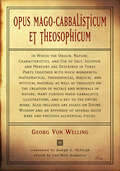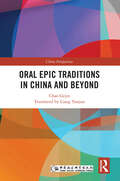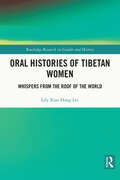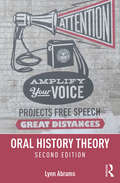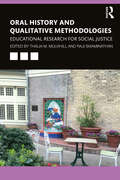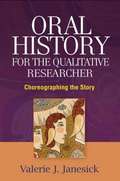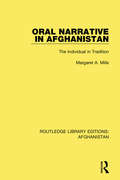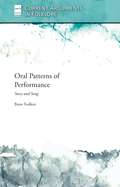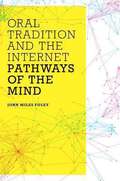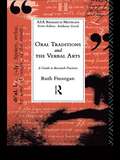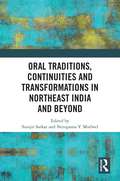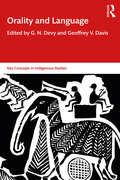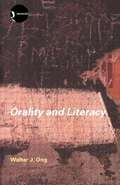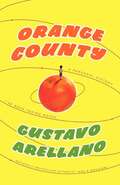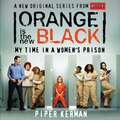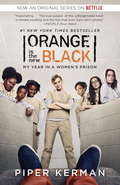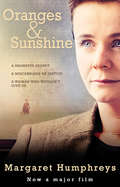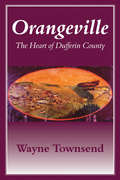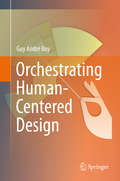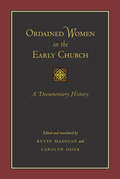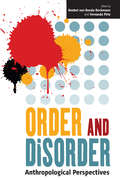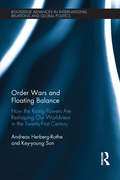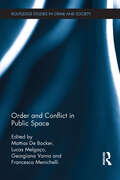- Table View
- List View
Opus Mago-Cabbalisticum Et Theosophicum
by Georg Von Welling“This is the sort of theological resource upon which The Da Vinci Code and books like it are based. This book says things are hidden and meant to be found.” —Joseph McVeigh, translatorAfter nearly three hundred years, one of the most important alchemical and magical texts of all time has finally been translated into English! In Goethe’s immortal play, Faust, the brooding hero reflects upon the vainness of earthly knowledge and education. He opens a book of magic and is transfixed by an illustration of the magical universe. He resolves there and then to become a magician. The book that fired Goethe’s imagination for that dramatic scene was a real book—the book of forbidden knowledge that evoked every mystical cliché, Opus Mago-Cabbalisticum et Theosophicum.This first ever English edition of Opus Mago-Cabbalisticum et Theosophicum will appeal to anyone interested in the history or practical aspects of alchemy, astrology, magick, Rosicrucianism, esoteric Freemasonry, and the Golden Dawn. A perfect addition to any library of classic esoteric literature, this edition reproduces famous illustrations.
Oral Epic Traditions in China and Beyond (China Perspectives)
by Chao GejinThis volume is the masterpiece of Chao Gejin, one of the best-known Chinese scholars of Epic studies, representing his most influential works on the change of the nature of the Epic across the twentieth century. The discussion ranges from Homeric and Indo-European epics to renewed discoveries of age-old African and Asian epics. The author details developments in research from Parry and Lord’s work on Serbo-Croat oral poetry to his own research on the Mongol heroic epic. The book traces the formation of theoretical systems such as Oral Formulaic Theory, Ethnopoetics and Performance Theory, and ends with the author’s explorations of the 20th-century Mongolian bard Arimpil’s singing of his native epic poetry. Using methods that previous scholars used to demonstrate the fundamentally oral nature of the Homeric epic, Chao brings to light the poetic richness of the still-living Mongol oral epic tradition. Students and scholars of epic studies, literature, folklore and anthropology will find this an essential reference.
Oral Histories of Tibetan Women: Whispers from the Roof of the World (Routledge Research in Gender and History)
by Lily Xiao LeeThrough the translated stories of twenty Tibetan women of various backgrounds, ages and occupations who were alive in the twentieth century, this book presents broad, under explored and engaging perspectives on Tibetan culture and politics, ethnicity or mixed ethnicity, art, marriage, religion, education and values. Offering a unique spectrum of primary sources, this book showcases interviews which were recorded in the 1990s and early 2000s which faithfully document Tibetan women telling their stories in their own words and situates these stories in their historical and socio-cultural contexts. These women were historically and religiously significant, such as a tulku (an incarnate), and tribal and local leaders, as well as ordinary women, such as poor peasants, the urban poor and women in polyandrous marriages. An important and unique contribution to the understanding of Tibetan women, this book is a valuable resource for those in the fields of Anthropology, Women and Gender Studies, Applied History, Contemporary China Studies, and Indigenous Studies.
Oral History Theory
by Lynn AbramsOral history is increasingly acknowledged as a key tool for anyone studying the history of the recent past, and Oral History Theory provides a comprehensive, systematic and accessible overview of this important field. Combining the study of theories drawn from disciplines ranging from linguistics to psychoanalysis with the observations of practitioners and including extensive examples of oral history practice from around the world, this book constitutes the first integrated discussion of oral history theory. Structured around key themes such as the peculiarities of oral history, the study of the self, subjectivity and intersubjectivity, memory, narrative, performance, power and trauma, each chapter provides a clear and user-friendly explanation of the various theoretical approaches, illustrating these with examples from the rich field of published oral history and making suggestions for the practicing oral historian. This second edition includes a new chapter on trauma and ethics, a preface discussing new developments in the field and updated glossary and further reading sections. Supplemented by a new companion website (www.routledge.com/cw/abrams) containing a comprehensive range of case studies, audio material and further resources, this book will be invaluable to experienced and novice oral historians, professionals, and students who are new to the discipline.
Oral History and Qualitative Methodologies: Educational Research for Social Justice
by Raji Swaminathan Thalia M. MulvihillOral History and Qualitative Methodologies: Educational Research for Social Justice examines oral history methodological processes involved in the doing of oral history as well as the theoretical, historical, and knowledge implications of using oral history for social justice projects. Oral history in qualitative research is an umbrella term that integrates history, life history, and testimony accounts. Oral history draws from various social science disciplines, including educational studies, history, indigenous studies, sociology, anthropology, ethnic studies, women’s studies, and youth studies. The book argues for the further development of a pedagogical culture related to oral history for educational research as part of the effort to diversify the range of human experiences educators, community members, and policy makers incorporate into knowledge-making and knowledge-using processes. Early career researchers, novice researchers, as well as experienced researchers are invited to join social science educational researchers in developing their own oral history projects using all of the tools, dispositions, and epistemologies affiliated with qualitative inquiry. The book will be of use in courses on qualitative research methods, history, anthropology, women’s studies, and education disciplines as well as by community organizations who want to use oral history to preserve the history of communities and advance social justice projects.
Oral History for the Qualitative Researcher
by Ruthellen Josselson Valerie JanesickOral history is a particularly useful way to capture ordinary people's lived experiences. This innovative book introduces the full array of oral history research methods and invites students and qualitative researchers to try them out in their own work. Using choreography as an organizing metaphor, the author presents creative strategies for collecting, representing, analyzing, and interpreting oral history data. Instructive exercises and activities help readers develop specific skills, such as nonparticipant observation, interviewing, and writing, with a special section on creating found data poems from interview transcripts. Also covered are uses of journals, court transcripts, and other documents; Internet resources, such as social networking sites; and photography and video. Emphasizing a social justice perspective, the book includes excerpts of oral histories from 9/11 and Hurricane Katrina, among other detailed case examples.
Oral Narrative in Afghanistan: The Individual in Tradition (Routledge Library Editions: Afghanistan #2)
by Margaret A. MillsThis book, first published in 1990, studies the oral fiction entertainments of Afghanistan by focusing on aspects of the oral narrative process which can be observed in individual performances.
Oral Patterns of Performance: Story and Song
by Barre ToelkenTo many Native American cultures, songs and stories are dramatic enactments of reality, and words bring reality into existence. In this chapter from his award-winning book, The Anguish of Snails, Toelken thoughtfully approaches a number of stories from Native American traditions, discussing how narratives can be touchstones of shared values among closely associated traditional people and how songs and stories go far beyond an evening's entertainment or "lessons” about life. A traditional narrative can be a culturally structured way of thinking and of experiencing the patterns that make culture real.
Oral Tradition and the Internet: Pathways of the Mind
by John Miles FoleyThe major purpose of this book is to illustrate and explain the fundamental similarities and correspondences between humankind's oldest and newest thought-technologies: oral tradition and the Internet. Despite superficial differences, both technologies are radically alike in depending not on static products but rather on continuous processes, not on "What?" but on "How do I get there?" In contrast to the fixed spatial organization of the page and book, the technologies of oral tradition and the Internet mime the way we think by processing along pathways within a network. In both media it's pathways--not things--that matter. To illustrate these ideas, this volume is designed as a "morphing book," a collection of linked nodes that can be read in innumerable different ways. Doing nothing less fundamental than challenging the default medium of the linear book and page and all that they entail, Oral Tradition and the Internet shows readers that there are large, complex, wholly viable, alternative worlds of media-technology out there--if only they are willing to explore, to think outside the usual, culturally constructed categories. This "brick-and-mortar" book exists as an extension of The Pathways Project (http://pathwaysproject.org), an open-access online suite of chapter-nodes, linked websites, and multimedia all dedicated to exploring and demonstrating the dynamic relationship between oral tradition and Internet technology
Oral Traditions and the Verbal Arts: A Guide to Research Practices (The ASA Research Methods)
by Ruth FinneganThe study of oral traditions and verbal arts leads into an area of human culture to which anthropologists are increasingly turning their attention. Oral Traditions and the Verbal Arts provides up-to-date guidance on how to approach the study of oral form and their performances, treating both the practicalities of fieldwork and the methods by which oral texts and performances can be observed, collected or analysed. It also relates to those current controversies about the nature of performance and of 'text'.Designed as a practical and systematic introduction to the processes and problems of researching in this area, this is an invaluable guide for students, and lecturers of anthropology and cultural studies and also for general readers who are interested in enjoying oral literature for its own sake.
Oral Traditions, Continuities and Transformations in Northeast India and Beyond
by Surajit Sarkar Nerupama Y. ModwelNortheast India is home to many distinct communities and is an area of incredible ethnic, religious, and linguistic diversity. This book explores the shared cultural heritage among the highland and river valley communities of Northeast India and mainland South East Asia, including South China, through oral traditions. It looks at these shared cultural traditions and suggests new ways of understanding and interpreting the heritage of Northeast India. Oral traditions often bring forward an unexpected twist in understanding historical and cultural links, and this volume explores this using local knowledge and innovative engagements with oral traditions in multiple ways, from folklore and language to performative traditions. The essays in this volume examine how communities build new meanings from old traditions, often as a recognition of the tension between conservation and creation, between individual interpretation and social consensus. They offer interesting parallels on how oral traditions behave in different socio-economic contexts, and also examine how oral traditions and memory interact with the digital world’s penetration in the remote areas. This volume will be useful for scholars and researchers of Northeast India, sociology, sociology of culture, cultural studies, ethnic studies, anthropology, folkloristics, and political sociology.
Orality and Language (Key Concepts in Indigenous Studies)
by G. N. Devy Geoffrey V. DavisPart of the series Key Concepts in Indigenous Studies, this book focuses on the concepts that recur in any discussion of the society, culture and literature among indigenous peoples. This book, the fourth in a five-volume series, deals with the two key concepts of language and orality of indigenous peoples from Asia, Australia, North America and South America. With contributions from renowned scholars, activists and experts from across the globe, it looks at the intricacies of oral transmission of memory and culture, literary production and transmission, and the nature of creativity among indigenous communities. It also discusses the risk of a complete decline of the languages of indigenous peoples, as well as the attempts being made to conserve these languages. Bringing together academic insights and experiences from the ground, this unique book, with its wide coverage, will serve as a comprehensive guide for students, teachers and scholars of indigenous studies. It will be essential reading for those in social and cultural anthropology, tribal studies, sociology and social exclusion studies, politics, religion and theology, cultural studies, literary and postcolonial studies, and Third World and Global South studies, as well as activists working with indigenous communities.
Orality and Literacy
by Kristina Fagan Keith Thor Carlson Natalia Khanenko-FriesenOrality and Literacy investigates the interactions of the oral and the literate through close studies of particular cultures at specific historical moments. Rejecting the 'great-divide' theory of orality and literacy as separate and opposite to one another, the contributors posit that whatever meanings the two concepts have are products of their ever-changing relationships to one another.Through topics as diverse as Aboriginal Canadian societies, Ukrainian-Canadian narratives, and communities in ancient Greece, Medieval Europe, and twentieth-century Asia, these cross-disciplinary essays reveal the powerful ways in which cultural assumptions, such as those about truth, disclosure, performance, privacy, and ethics, can affect a society's uses of and approaches to both the written and the oral. The fresh perspectives in Orality and Literacy reinvigorate the subject, illuminating complex interrelationships rather than relying on universal generalizations about how literacy and orality function.
Orality and Literacy: The Technologizing of the Word
by Walter J. OngThis classic work explores the vast differences between oral and literate cultures and offers a brilliantly lucid account of the intellectual, literary and social effects of writing, print and electronic technology.
Orange County: A Personal History (Images Of Baseball Ser.)
by Gustavo ArellanoThe story began in 1918, when Gustavo Arellano's great-grandfather and grandfather arrived in the United States, only to be met with flying potatoes. They ran, and hid, and then went to work in Orange County's citrus groves, where, eventually, thousands of fellow Mexican villagers joined them. Gustavo was born sixty years later, the son of a tomato canner who dropped out of school in the ninth grade and an illegal immigrant who snuck into this country in the trunk of a Chevy. Meanwhile, Orange County changed radically, from a bucolic paradise of orange groves to the land where good Republicans go to die, American Christianity blossoms, and way too many bad television shows are green-lit. Part personal narrative, part cultural history, Orange County is the outrageous and true story of the man behind the wildly popular and controversial column ¡Ask a Mexican! and the locale that spawned him. It is a tale of growing up in an immigrant enclave in a crime-ridden neighborhood, but also in a promised land, a place that has nourished America's soul and Gustavo's family, both in this country and back in Mexico, for a century. Nationally bestselling author, syndicated columnist, and the spiciest voice of the Mexican-American community, Gustavo Arellano delivers the hilarious and poignant follow-up to ¡Ask a Mexican!, his critically acclaimed debut. Orange County not only weaves Gustavo's family story with the history of Orange County and the modern Mexican-immigrant experience but also offers sharp, caliente insights into a wide range of political, cultural, and social issues.
Orange Is the New Black: My Time in a Women's Prison
by Piper KermanWith her career, live-in boyfriend and loving family, Piper Kerman barely resembles the rebellious young woman who got mixed up with drug runners and delivered a suitcase of drug money to Europe over a decade ago. But when she least expects it, her reckless past catches up with her; convicted and sentenced to fifteen months at an infamous women's prison in Connecticut, Piper becomes inmate #11187-424. From her first strip search to her final release, she learns to navigate this strange world with its arbitrary rules and codes, its unpredictable, even dangerous relationships. She meets women from all walks of life, who surprise her with tokens of generosity, hard truths and simple acts of acceptance. Now an original comedy-drama series from Netflix, Piper's story is a fascinating, heartbreaking and often hilarious insight into life on the inside.
Orange Is the New Black: My Time in a Women's Prison
by Piper KermanWith her career, live-in boyfriend and loving family, Piper Kerman barely resembles the rebellious young woman who got mixed up with drug runners and delivered a suitcase of drug money to Europe over a decade ago. But when she least expects it, her reckless past catches up with her; convicted and sentenced to fifteen months at an infamous women's prison in Connecticut, Piper becomes inmate #11187-424. From her first strip search to her final release, she learns to navigate this strange world with its arbitrary rules and codes, its unpredictable, even dangerous relationships. She meets women from all walks of life, who surprise her with tokens of generosity, hard truths and simple acts of acceptance. Now an original comedy-drama series from Netflix, Piper's story is a fascinating, heartbreaking and often hilarious insight into life on the inside.
Orange Is the New Black: My Year in a Women's Prison
by Piper KermanA compelling, often hilarious, and unfailingly compassionate portrait of life inside a womens' prison. When Piper Kerman was sent to prison for a ten-year-old crime, she barely resembled the reckless young woman she'd been when, shortly after graduating Smith College, she'd committed the misdeeds that would eventually catch up with her. <P><P>Happily ensconced in a New York City apartment, with a promising career and an attentive boyfriend, she was suddenly forced to reckon with the consequences of her very brief, very careless dalliance in the world of drug trafficking. <P><P>Kerman spent thirteen months in prison, eleven of them at the infamous federal correctional facility in Danbury, Connecticut, where she met a surprising and varied community of women living under exceptional circumstances. <P><P>In Orange Is the New Black, Kerman tells the story of those long months locked up in a place with its own codes of behavior and arbitrary hierarchies, where a practical joke is as common as an unprovoked fight, and where the uneasy relationship between prisoner and jailer is constantly and unpredictably recalibrated. <P><P>Revealing, moving, and enraging, Orange Is the New Black offers a unique perspective on the criminal justice system, the reasons we send so many people to prison, and what happens to them when they're there.
Oranges and Sunshine: Empty Cradles
by Margaret HumphreysAlso published as Empty Cradles.In 1986 Margaret Humphreys, a Nottingham social worker, investigated a woman's claim that, aged four, she had been put on a boat to Australia by the British government. At first incredulous, Margaret discovered that this was just the tip of an enormous iceberg. Up to 150,000 children, some as young as three years old, had been deported from children's homes in Britain and shipped off to a 'new life' in distant parts of the Empire, right up until as recently as 1970.Many were told that their parents were dead, and parents often believed that their children had been adopted in Britain. In fact, for many children it was to be a life of horrendous physical and sexual abuse far away from everything they knew. Margaret reveals how she unravelled this shocking secret and how it became her mission to reunite these innocent and unwilling exiles with their families in Britain before it was too late.
Orangeville: The Heart of Dufferin County
by Wayne TownsendThe Town of Orangeville has a colourful, exciting past – a history being documented in book form for the first time. From the early days of the Irish pioneers escaping the political problems of Ireland to the present influx of new residents fleeing the pressures of cities, Orangeville has been a town that has adapted well to change, always ready for new ideas. The strength of the community has been the people who have chosen to live there and who have left us interesting traces of their lives and the times. Much of the material used to research this book comes from newspapers, diaries, letters and other first-person documents, and archival photographs. Wherever possible, original quotes and stories in the language of the residents of the town appear throughout this history. The story of Orangeville and its surrounding area starts with the story of the Credit River, which rises within the town limits and maintains its presence as the town enters the 21st century. Brimming with stories never before heard, the pages are filled with humour, sadness and the range of emotions characteristic of a small Ontario town. For some the book will awaken memories; for others, it will introduce them to the community where they have chosen to live.
Orchestrating Human-Centered Design
by Guy BoyThe time has come to move into a more humanistic approach of technology and to understand where our world is moving to in the early twenty-first century. The design and development of our future products needs to be orchestrated, whether they be conceptual, technical or organizational. Orchestrating Human-Centered Design presents an Orchestra model that attempts to articulate technology, organizations and people. Human-centered design (HCD) should not be limited to local/short-term/linear engineering, but actively focus on global/long-term/non-linear design, and constantly identify emergent properties from the use of artifacts. Orchestrating Human-Centered Design results from incremental syntheses of courses the author has given at the Florida Institute of Technology in the HCD PhD program. It is focused on technological and philosophical concepts that high-level managers, technicians and all those interested in the design of artifacts should consider. Our growing software -intensive world imposes better knowledge on cognitive engineering, life-critical systems, complexity analysis, organizational design and management, modeling and simulation, and advanced interaction media, and this well-constructed and informative book provides a road map for this.
Ordained Women in the Early Church: A Documentary History
by Kevin MadiganIn a time when the ordination of women is an ongoing and passionate debate, the study of women's ministry in the early church is a timely and significant one. There is much evidence from documents, doctrine, and artifacts that supports the acceptance of women as presbyters and deacons in the early church. While this evidence has been published previously, it has never before appeared in one complete English-language collection.With this book, church historians Kevin Madigan and Carolyn Osiek present fully translated literary, epigraphical, and canonical references to women in early church offices. Through these documents, Madigan and Osiek seek to understand who these women were and how they related to and were received by, the church through the sixth century. They chart women's participation in church office and their eventual exclusion from its leadership roles. The editors introduce each document with a detailed headnote that contextualizes the text and discusses specific issues of interpretation and meaning. They also provide bibliographical notes and cross-reference original texts. Madigan and Osiek assemble relevant material from both Western and Eastern Christendom.
Order And Disorder: Anthropological Perspectives
by Keebet von Benda-Beckmann Fernanda PirieDisorder and instability are matters of continuing public concern. Terrorism, as a threat to global order, has been added to preoccupations with political unrest, deviance and crime. Such considerations have prompted the return to the classic anthropological issues of order and disorder. Examining order within the political and legal spheres and in contrasting local settings, the papers in this volume highlight its complex and contested nature. Elaborate displays of order seem necessary to legitimate the institutionalization of violence by military and legal establishments, yet violent behaviour can be incorporated into the social order by the development of boundaries, rituals and established processes of conflict resolution. Order is said to depend upon justice, yet injustice legitimates disruptive protest. Case studies from Siberia, India, Indonesia, Tibet, West Africa, Morocco and the Ottoman Empire show that local responses are often inconsistent in their valorization, acceptance and condemnation of disorder.
Order Wars and Floating Balance: How the Rising Powers Are Reshaping Our Worldview in the Twenty-First Century (Routledge Advances in International Relations and Global Politics)
by Andreas Herberg-Rothe Key-young SonA sense of order has irreversibly retreated at the turn of the twenty-first century with the rise of such ancient civilizations as China and India and the militant resurgence of Islamic groups. The United States and like-minded states want to maintain the once-dominant international and global order buttressed by a set of mainly Western value systems and institutions. Nevertheless, challengers have sought to redraw the international and global order according to their own ideas and preferences, while selectively accommodating and taking advantage of the established order. Because of this, the entire world is teetering on the brink of an order war. This book is a synthesis of two separate bodies of thoughts, from Western and East Asian ideas and philosophies respectively. The authors deploy the major ideas of key Western and East Asian thinkers to shed a new light on their usefulness in understanding the transition of global order. They locate new ideas to overcome the contradictions of the late modern world and provide some ideational building blocks of a new global order. The new concepts proposed are: recognition between the great civilizations; a harmony and floating balance between and within contrasts—individual versus community, freedom versus equality—;and mediation between friends and foes. As the former Israeli Prime Minister Yitzhak Rabin put it, "you don’t need to make peace with your friends, you have to make peace with your foes." The values of the West as well as that of the East cannot survive in a globalized world by taking them as absolute, but only by balancing them to those of the other great civilizations of the world.
Order and Conflict in Public Space (Routledge Studies in Crime and Society)
by Mattias De Backer, Lucas Melgaço, Georgiana Varna and Francesca MenichelliWhich public and whose space? The understanding of public space as an arena where individuals can claim full use and access hides a reality of constant negotiation, conflict and surveillance. This collection uses case studies concerning the management, use, and transgression of public space to invite reflection on the way in which everyday social interaction is framed and shaped by the physical environment and vice versa. International experts from fields including geography, criminology, sociology and urban studies come together to debate the concepts of order and conflict in public space. This book is divided into two parts: spaces of control, and spaces of transgression. Section I focuses on formal and informal surveillance and the politics of control, using case studies to compare strategies in spaces including Olympic cities, luxury skyscrapers, residential neighbourhoods and shopping malls. Section II focuses on transgressive or deviant behaviour in public spaces, with case studies examining behaviour in nightlife districts, governance of homelessness, boy-racer culture and abortion protests. The epilogue concludes the book with an exploration of possible future avenues for research on public space, and a critical appraisal of the concept of public space itself. This interdisciplinary collection will be of interest to students, researchers and professionals in the areas of criminology, sociology, surveillance studies, human and social geography, and urban studies and planning.
